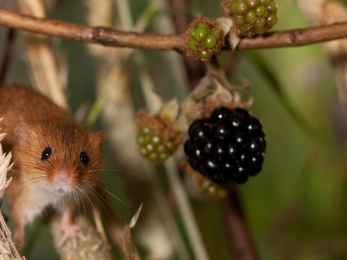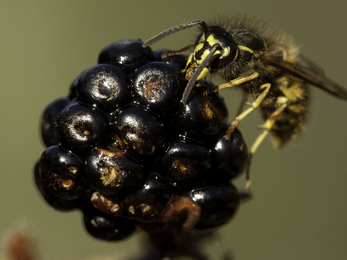For many of us, blackberries are the only foraged food we’ve ever considered, never mind tasted. Blackberry-picking conjures images of late summer afternoons in the country, coming home with a basket or tub full of shining purple-black treasures, scratched arms and stained purple lips.
Blackberries
Blackberries (c) Amy Lewis
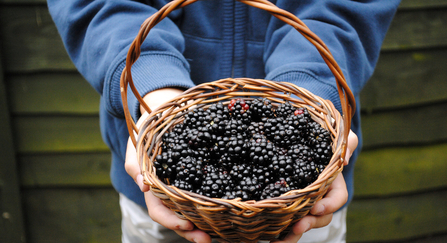
Blackberry picking (c) Amy Lewis
Late August and September is the time to be out there, gathering the fruits of the hedgerow and filling the larder with a squirrel-like satisfaction. It’s like storing up a bit of summer’s sunshine against the winter to come.
Brambles (blackberry plants) are a woodland-edge species, which means that hedgerows suit them well. Naturally, they grow towards the light, so long canes sprout out from the shade into the open. Left to their own devices, when these canes touch the ground they develop roots and then send up new vertical shoots
Blackberries are hardy, determined, and can spread rapidly to form an impenetrable thicket – and you can guarantee the best-looking fruit will be right out of reach!
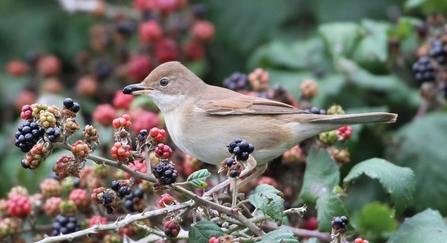
Whitethroat with blackberries (c) Margaret Holland
Those dense tangles make a wonderful wildlife habitat, though, providing shelter for hedgehogs, small mammals, reptiles and nesting birds, as well as a nursery site for young trees to grow without being nibbled.
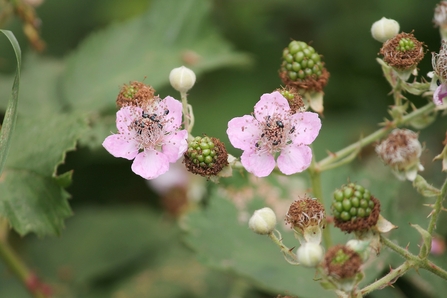
Blackberry flowers
The pinky-white flowers provide nectar for bees, moths and butterflies, the leaves support the caterpillars of many moths, such as common pug, oak eggar and peach blossom, but it’s the fruit that’s the true bounty.
Competing with us for the harvest, thrushes, finches and blackbirds, mammals from bank voles to badgers, and, of course, voracious wasps, all relish a blackberry.
The place of blackberries in our history – their seeds were recovered from the belly of Neolithic man at Walton-in-the-Naze – is underlined by the myths and legends surrounding them.
The best-known is that the Devil spits (or pees) on them on Michaelmas Day (29th September), having landed in a bramble bush when he fell from Heaven. You can move the date a little – Old Michaelmas day was on 10th or 11th October before the shift from the Julian to the Gregorian calendar.
I never let that worry me – the condition of late blackberries depends on the season. Falling into brambles also features in the Greek legend of Belleraphon, who dared to ride the flying horse Pegasus and was blinded by thorns when he was thrown into a blackberry bush.
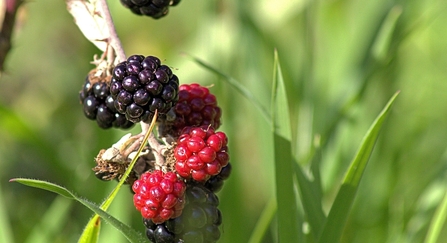
Blackberries (c) Lauren Heather
The plant also has a long history of medicinal use. It was once thought that a child could be cured of a hernia or rupture by passing the patient under the loop formed by a rooted shoot. More reliably, the leaves are astringent and tonic, providing a valuable remedy for diarrhoea and dysentery.
During the Civil War temporary truces were called periodically to allow both sides to forage for blackberries to cure the latter. The herbalist Culpeper, who fought in the Civil War himself, considered the berries as a ‘powerful remedy against the most venomous serpents’ and suggested the leaves, boiled in lye, as a cure for itchy scalps and sores on the head and as black hair-dye - blondes with sore scalps might do better to find a different remedy!
Eating blackberries can also make you look younger – they’re high in anti-oxidants, promoting healthy skin. There are hundreds of recipes to use or preserve your harvest of berries, from desserts like traditional pies and more refined sorbets to pickles and chutneys, sauces to serve with game, wines and liqueurs.
Gather your berries from a sunny hedgerow away from busy roads, avoiding the lower-growing fruit. A walking stick can be useful to gently pull the clusters of fruit within reach without getting torn to shreds.
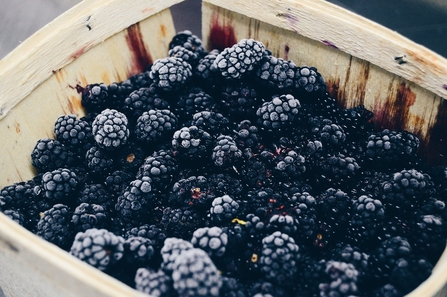
Collect the fruit in a basket or tub – putting them in a plastic bag often results in squashed berries at best, or the loss of the whole lot when the bag gets snagged on a thorn.
Use the berries as soon as possible or freeze them for later; they don’t keep well. They do freeze admirably, though, so you can collect the produce of several pickings to make a big batch of jam or jelly. My favourite recipe is for spiced pickled blackberries, wherein the whole fruits are preserved in a spicy, tangy-sweet syrup – a real treat with bread and cheese! You can download this recipe and some of my other favourites further down the page.
Brambles are prolific fruiters, and there are always plenty of berries out of human reach, but when you’re gathering, don’t forget the wildlife – leave plenty of fruit for hungry birds, and be careful not to break down the bushes and disturb the prickly habitat.
Whatever wild food you gather, remember to ask the permission of the landowner if you’re on private land, and make sure you can positively identify the species you want.
Dr Cath Price
Engagement Officer Shropshire Wildlife Trust
Download Dr Cath's favourite blackberry recipes below, which includes instructions for making:
Bramble jelly, Blackberry butter, Spiced pickled blackberries, and Blackberry chutney.


